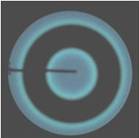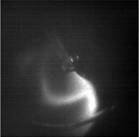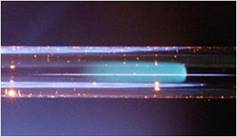研究内容
更新日時:2010年以前
マイクロ燃焼
マイクロ燃焼とは、系の代表寸法がいわゆる消炎距離と同程度か、それ以下であるような燃焼現象を意味します。本研究室では、マイクロ燃焼を利用して、燃焼を利用する小型携帯用電源や超小型燃料改質器のための熱源など、新しいコンセプトの燃焼技術創出に向けて研究を行っています。
マイクロスケール下で安定燃焼を実現するための熱管理として熱再生型燃焼の重要性が広く認識されているますが、本研究室ではかねてから、マイクロスケール下の熱再生を模擬した基礎研究の系として、「温度勾配を有するマイクロまたはメゾスケールチャネル」の利用を提案しています。極端に簡単化された一次元の系において、火炎が自発的な着火消炎を繰り返す現象(FREI: Flames with repetitive extinction and ignition)を初めて見いだしたほか、二次元円形チャネルでは安定な燃焼現象よりも、火炎によるパターン形成(Pelton-like, spiral, broken and triple-branch flames)が優勢となることがわかりました。また上記の基礎実験系を転用することによって、基礎燃焼学的な着火と火炎伝播の関係や、熱再生を受ける燃焼過程一般に成立する反応限界の特定に関する研究も行っています。



関連論文
-
Aiwu Fan, Sergey S. Minaev, Evgeniy V. Sereshchenko, Yosuke Tsuboi, Hiroshi Oshibe,Hisashi Nakamura and Kaoru Maruta, Dynamic behavior of splitting flames in a heated channel, Combustion, Explosion, and Shock Waves, Vol. 45, No. 3:245-250 (2009)
doi:10.1007/s10573-009-0032-6, Link. -
Sergey S. Minaev, Evgeniy V. Sereshchenko, Roman V. Fursenko, Aiwu Fan, and Kaoru Maruta, Splitting Flames in a Narrow Channel with a Temperature Gradient in the Walls, Combustion, Explosion, and Shock Waves, Vol. 45, No. 2:119-125 (2009)
doi:10.1007/s10573-009-0016-6, Link. -
Aiwu Fan, Sergey Minaev, Evgeniy Sereshchenko, Roman Fursenko, Sudarshan Kumar, Wei Liu, Kaoru Maruta, Experimental and numerical investigations of flame pattern formations in a radial microchannel, Proceedings of the Combustion Institute, Vol. 32, Issue 2: 3059-3066 (2009)
doi:10.1016/j.proci.2008.06.092, Link. -
Sudarshan Kumar, Kaoru Maruta, S. Minaev, and R. Fursenko, Appearance of target pattern and spiral flames in radial microchannels with CH4-air mixtures, Physics of Fluids, Vol. 20: 024101 (2008).
doi:10.1063/1.2836670. Link. -
Aiwu Fan, Sergey Minaev, Sudarshan Kumar, Wei Liu and Kaoru Maruta, Experimental study on flame pattern formation and combustion completeness in a radial microchannel, Journal of Micromechanics and Microengineering, Vol.17: 2398-2406 (2007)
doi: 10.1088/0960-1317/17/12/002, Link. -
Sudarshan Kumar, Kaoru Maruta and S. Minaev, Experimental investigations on the combustion behavior of methane-air mixtures in a micro-scale radial combustor configuration, Journal of Micromechanics and Microengineering, Vol.17: 900-908 (2007)
doi: 10.1088/0960-1317/17/5/008, Link. -
Sudarshan Kumar, Kaoru Maruta and Sergey Minaev, Pattern formation of flames in radial microchannels with lean methane-air mixtures, Physical Review E, Vol. 75, Issue 1: 016208 (2007)
doi: 10.1103/PhysRevE.75.016208. Link. -
Sergey Minaev, Kaoru Maruta, and Roman Fursenko, Nonlinear dynamics of flame in a narrow channel with a temperature gradient, Combustion Theory and Modelling, Vol. 11: 187- 203 (2007),
doi: 10.1080/13647830600649364. Link. -
Sudarshan Kumar, Kaoru Maruta and Sergey Minaev, On the formation of multiple rotating pelton-like flame structures in radial microchannels with lean methane-air mixtures, Proceedings of the Combustion Institute, Vol. 31: 3261-3268 (2007)
doi:10.1016/j.proci.2006.07.174 , Link. -
Nam Il Kim, Takuya Kataoka, Shigenao Maruyama and Kaoru Maruta, Flammability limits of stationary flames in tubes at low pressure, Combustion and Flame, Vol. 141: 78-88 (2005)
doi:10.1016/j.combustflame.2004.12.011, Link. -
Kaoru Maruta, Takuya Kataoka, Nam Il Kim, Sergey Minaev and Roman Fursenko, Characteristics of combustion in a narrow channel with a temperature gradient, Proceedings of the Combustion Institute, Vol. 30: 2429-2436 (2005)
doi:10.1016/j.proci.2004.08.245, Link. -
Kaoru Maruta, J. K. Park, K. C. Oh, T. Fujimori, S. Minaev and R. Fursenko, Characteristics of Microscale Combustion in Narrow Heated Channel, Combustion, Explosion and Shock Waves, Vol. 40 No. 5: 516-523 (2004)
doi:10.1023/B:CESW.0000041403.16095.a8, Link. -
K. Maruta, K. Takeda, J. Ahn, K. Borer, L. Sitzki, P. D. Ronney and O. Deutschmann, Extinction Limits of Catalytic Combustion in Microchannels, Proceedings of the Combustion Institute, Vol. 29: 957-963 (2002)
doi:10.1016/S1540-7489(02)80121-3, Link.
